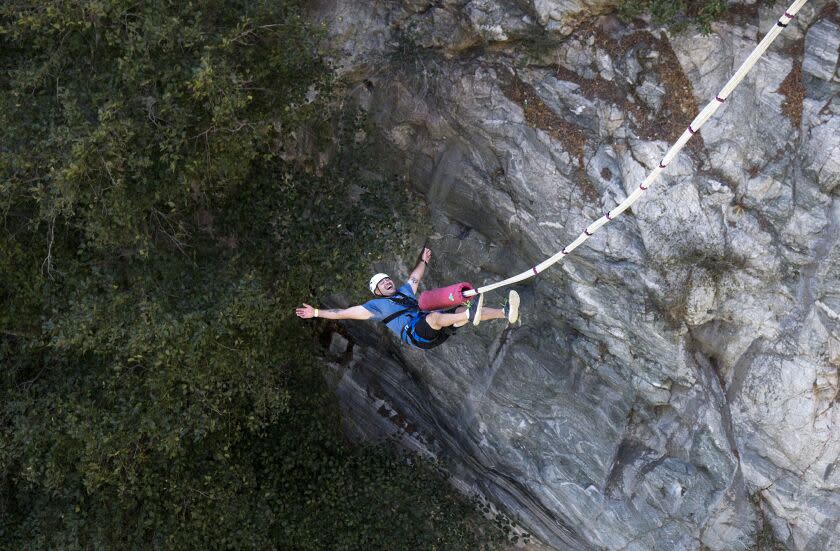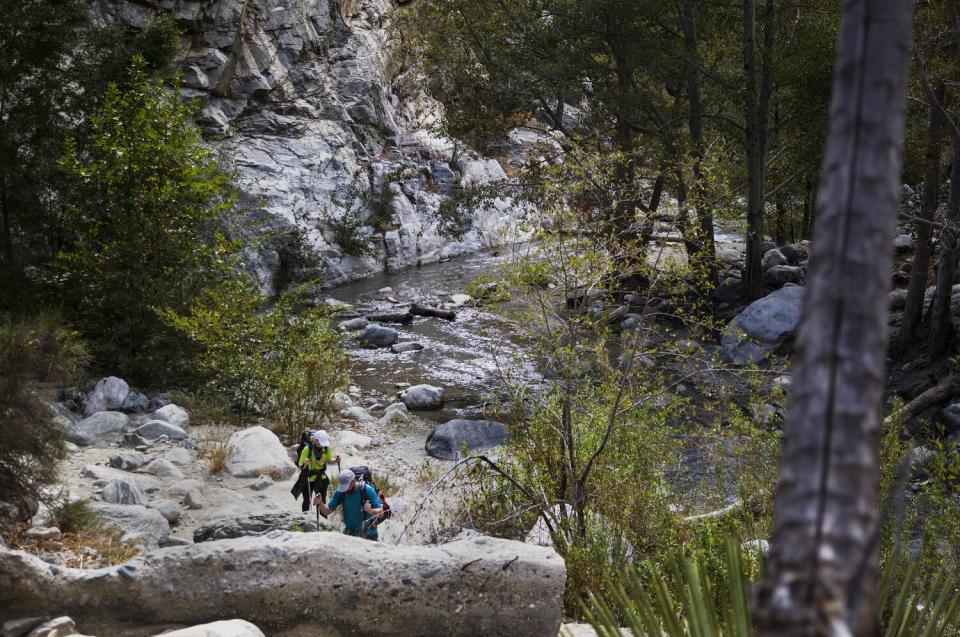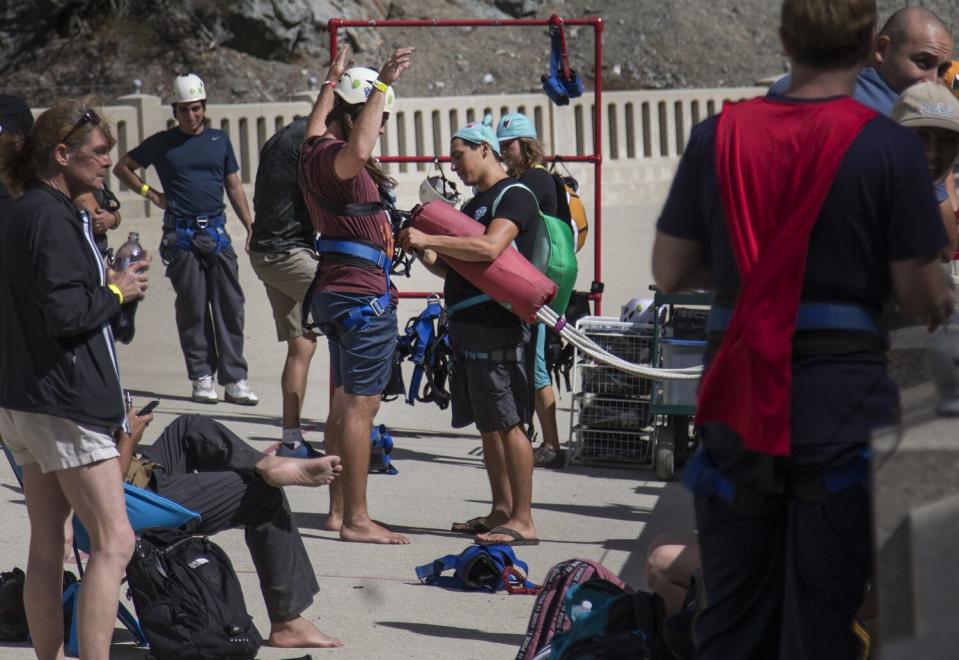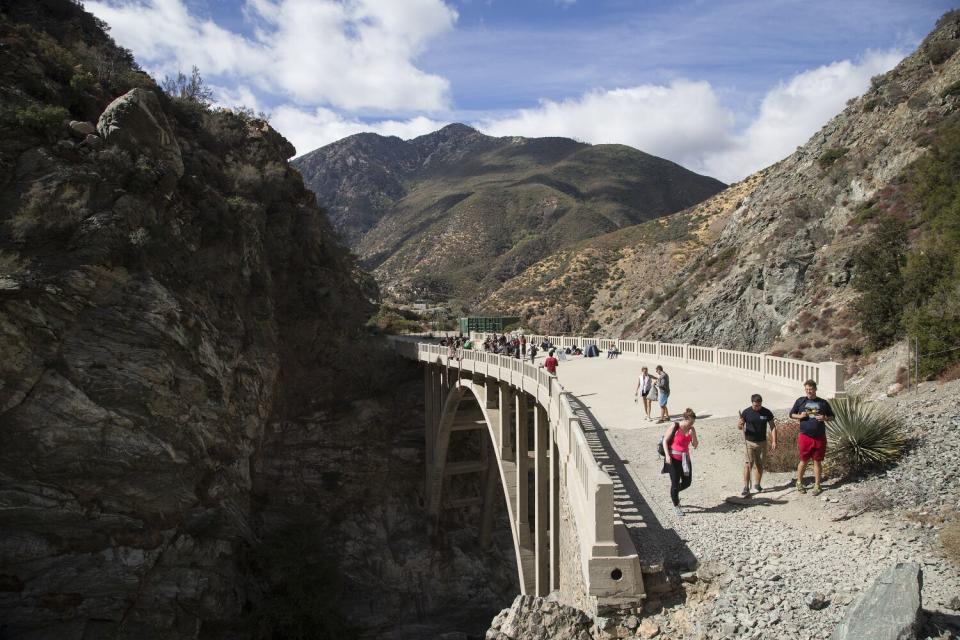Opponents seek to end a bungee-jumping venue, citing environmental and safety concerns

Dozens of bungee jumpers take an arduous five-mile hike each weekend to launch themselves off the 120-foot Bridge to Nowhere deep in the San Gabriel Mountains National Monument.
This is Bungee America, Southern California’s only commercial bungee-jumping venue, an extremely remote attraction on a 50-acre private inholding about 20 miles north of Azusa. And now, after 30 years of operating without a county conditional use permit, the popular operation is in trouble.
The volunteer citizens group Save the East Fork Assn. has sued the County of Los Angeles, the Los Angeles County Board of Supervisors and the county Department of Regional Planning to stop the operation, pending completion of an environmental impact report required under the California Environmental Quality Act.
The association and county officials are expected to face off in court Thursday. The outcome could determine the fate of the facility, which is within the Angeles National Forest’s Sheep Mountain Wilderness and the 346,177-acre San Gabriel Mountains National Monument.

“Bungee America’s unlawful operation has substantial impacts on the surrounding natural environment and the people who enjoy it,” according to the lawsuit, which accuses the county agencies of increasing risks to health and safety in the mountainous backcountry area by allowing the facility to sidestep the regulatory process.
Bungee America, it claims, operates an unpermitted chemical toilet and a helipad that enables a helicopter to transport staff, supplies and waste to and from the venue on the rugged East Fork of the San Gabriel River five miles from the nearest road. Unregulated effluent from customers, it suggests, may be making its way down into the upper reaches of the East Fork.
Then there is the issue of parking. Bungee America’s customers, according to the lawsuit, take up most of the spaces in a trailhead parking lot at the confluence of the East Fork and Cattle Canyon. The lot is meant to serve visitors who come to the mountains to picnic, swim in the nearby river, ride bicycles and hike.
Ron Jones, the owner of Bungee America, is an outdoorsman who has been featured bungee jumping on “Ripley’s Believe It or Not” and other TV shows. For years he has taken comfort in the fact that environmentalists, the U.S. Forest Service and other regulatory agencies have failed in their efforts to shut down his business.
Jones was unavailable for comment on the lawsuit. But in a 2016 interview with The Times, he said that “the Forest Service and extremist environmentalists have been doing everything they can to take control of my property.”
“But that will never happen,” he added. “I’ll still be here after the dust settles and my opponents are pushing up daisies.”
His attorney, John McClendon, also was unavailable for comment. But in a statement filed with the court, he denied that Bungee America operates an unpermitted helipad and bathroom.
To hear McClendon tell it, Bungee America's staff members routinely pick up visitors’ trash, and provide hikers and climbers with first aid and “a satellite link to civilization in times of emergency.” With help from paying customers and supporters, they also clean the entire five-mile trail "of trash and debris between the parking area at the trailhead and the property, every weekend,” he said.
“The U.S. Forest does little or nothing,” he added, “to keep the backcountry clean.”

Dana Dierkes, spokeswoman for the Angeles National Forest, declined to comment on the litigation. “It is inappropriate for us to comment as the bridge is not on National Forest System lands.”
But Ben White, president of the Save the East Fork Assn., called the dispute “a health and safety issue as much as anything else. What if there’s a flash flood or a wildfire when there’s 50 Bungee America customers out there?”
Meeting the requirements of permanent permits, he suggested, “would cost Bungee America hundreds of thousands of dollars for critically needed improvements such as proper toilets, an emergency exit plan, and a road for emergency access.”
The controversy revolves around the bridge, which was built in 1936 as part of a state road project up the East Fork. The project was abandoned in 1938 after catastrophic flooding. But the bridge remained, a spectacular incongruity over a cascading river bracketed by granite walls.
Jones bought the property in 2009 from descendants of a family that once ran a gold mine there. Los Angeles County assessor’s office records show that the property was sold for $242,570.
State health and safety officials first tried to shut down Jones’ operation in 2000, citing issues such as a lack of liability insurance and an expired license to operate as an amusement ride.
A year later, Bungee America was fined $5,000 in connection with "safety-related offenses," according to U.S. Department of Labor records, which indicate that the case was settled in 2003.

In 2014, critics pointed out that Bungee America was in an unincorporated county area zoned for agriculture, which does not permit commercial amusement businesses. Jones persuaded the Los Angeles County Board of Supervisors to approve a zoning change from agriculture to commercial use.
Two years later, he also requested a Clean Hands Waiver, which would allow the venue to continue operating while waiting for a conditional use permit from the county Department of Regional Planning.
In 2018, regional planning granted Bungee America the first of six Clean Hands Waiver permits, each subject to multiple conditions affecting operations at the site, including removal of zip-line equipment and other unpermitted structures, according to the lawsuit.
Most recently, according to a letter dated Feb. 8, 2022, the Department of Regional Planning extended Bungee America’s latest Clean Hands Waiver until Feb. 3, 2023.
The lawsuit seeks to have Bungee America’s waiver vacated because it failed to first complete an environmental impact analysis, including public comment required under the state Environmental Quality Act.
In the meantime, customers who make the two-hour trek to the Bridge to Nowhere pay $50 to stand in hiking boots at the edge of a small metal platform railing, stare at the boulders 120 feet below, then jump.
Bungee Jumping “off the Bridge to Nowhere into pitch black darkness” is available any night, according to facility’s web page, “upon special arrangement.”
This story originally appeared in Los Angeles Times.

